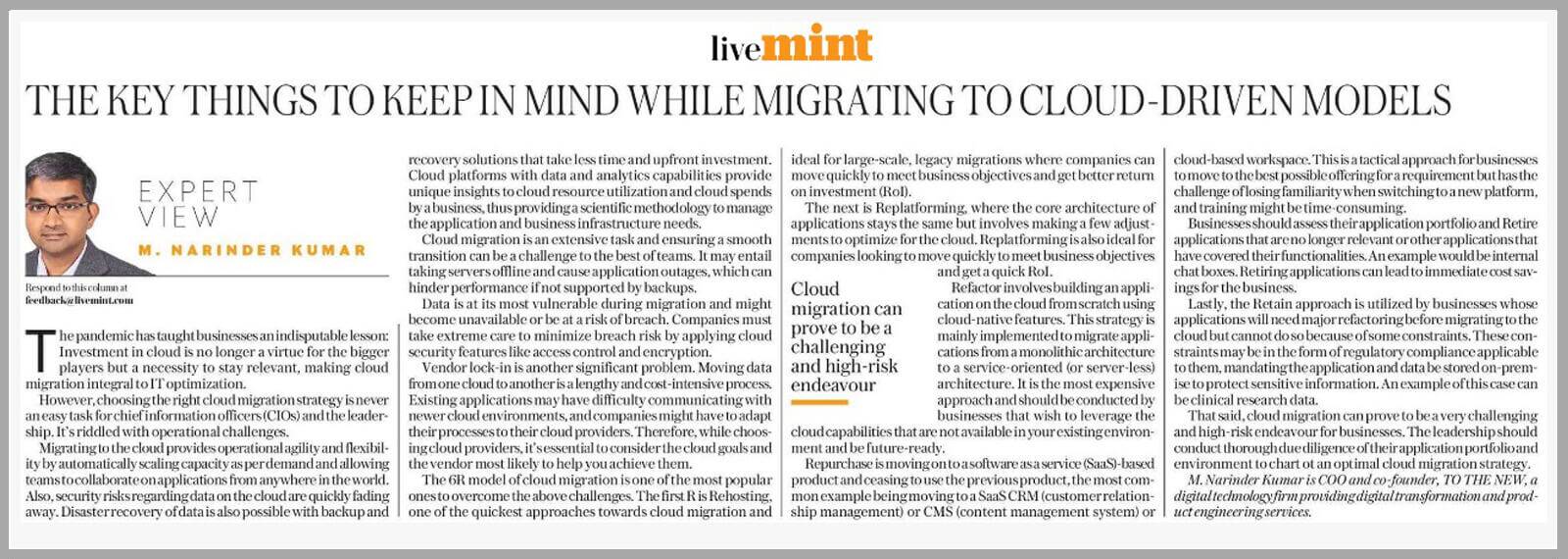The key things to keep in mind while migrating to cloud-driven models
By Narinder Kumar (Co-founder & COO, TO THE NEW)
The pandemic has taught businesses an indisputable lesson: Investment in cloud is no longer a virtue for the bigger players but a necessity to stay relevant, making cloud migration integral to IT optimization.
However, choosing the right cloud migration strategy is never an easy task for chief information officers (CIOs) and the leadership. It’s riddled with operational challenges.
Migrating to the cloud provides operational agility and flexibility by automatically scaling capacity as per demand and allowing teams to collaborate on applications from anywhere in the world. Also, security risks regarding data on the cloud are quickly fading away. Disaster recovery of data is also possible with backup and recovery solutions that take less time and upfront investment. Cloud platforms with data and analytics capabilities provide unique insights to cloud resource utilization and cloud spends by a business, thus providing a scientific methodology to manage the application and business infrastructure needs.
Cloud migration is an extensive task and ensuring a smooth transition can be a challenge to the best of teams. It may entail taking servers offline and cause application outages, which can hinder performance if not supported by backups.
Data is at its most vulnerable during migration and might become unavailable or be at a risk of breach. Companies must take extreme care to minimize breach risk by applying cloud security features like access control and encryption.
Vendor lock-in is another significant problem. Moving data from one cloud to another is a lengthy and cost-intensive process. Existing applications may have difficulty communicating with newer cloud environments, and companies might have to adapt their processes to their cloud providers. Therefore, while choosing cloud providers, it’s essential to consider the cloud goals and the vendor most likely to help you achieve them.
The 6R model of cloud migration is one of the most popular ones to overcome the above challenges.
The first R is Rehosting, one of the quickest approaches towards cloud migration and ideal for large-scale, legacy migrations where companies can move quickly to meet business objectives and get better return on investment (RoI).
The next is Replatforming, where the core architecture of applications stays the same but involves making a few adjustments to optimize for the cloud. Replatforming is also ideal for companies looking to move quickly to meet business objectives and get a quick RoI.
Refactor involves building an application on the cloud from scratch using cloud-native features. This strategy is mainly implemented to migrate applications from a monolithic architecture to a service-oriented (or server-less) architecture. It is the most expensive approach and should be conducted by businesses that wish to leverage the cloud capabilities that are not available in your existing environment and be future-ready.
Repurchase is moving on to a software as a service (SaaS)-based product and ceasing to use the previous product, the most common example being moving to a SaaS CRM (customer relationship management) or CMS (content management system) or cloud-based workspace. This is a tactical approach for businesses to move to the best possible offering for a requirement but has the challenge of losing familiarity when switching to a new platform, and training might be time-consuming.
Businesses should assess their application portfolio and Retire applications that are no longer relevant or other applications that have covered their functionalities. An example would be internal chat boxes. Retiring applications can lead to immediate cost savings for the business.
Lastly, the Retain approach is utilized by businesses whose applications will need major refactoring before migrating to the cloud but cannot do so because of some constraints. These constraints may be in the form of regulatory compliance applicable to them, mandating the application and data be stored on-premise to protect sensitive information. An example of this case can be clinical research data.
That said, cloud migration can prove to be a very challenging and high-risk endeavour for businesses. The leadership should conduct thorough due diligence of their application portfolio and environment to chart out an optimal cloud migration strategy.
Read the full article here.

